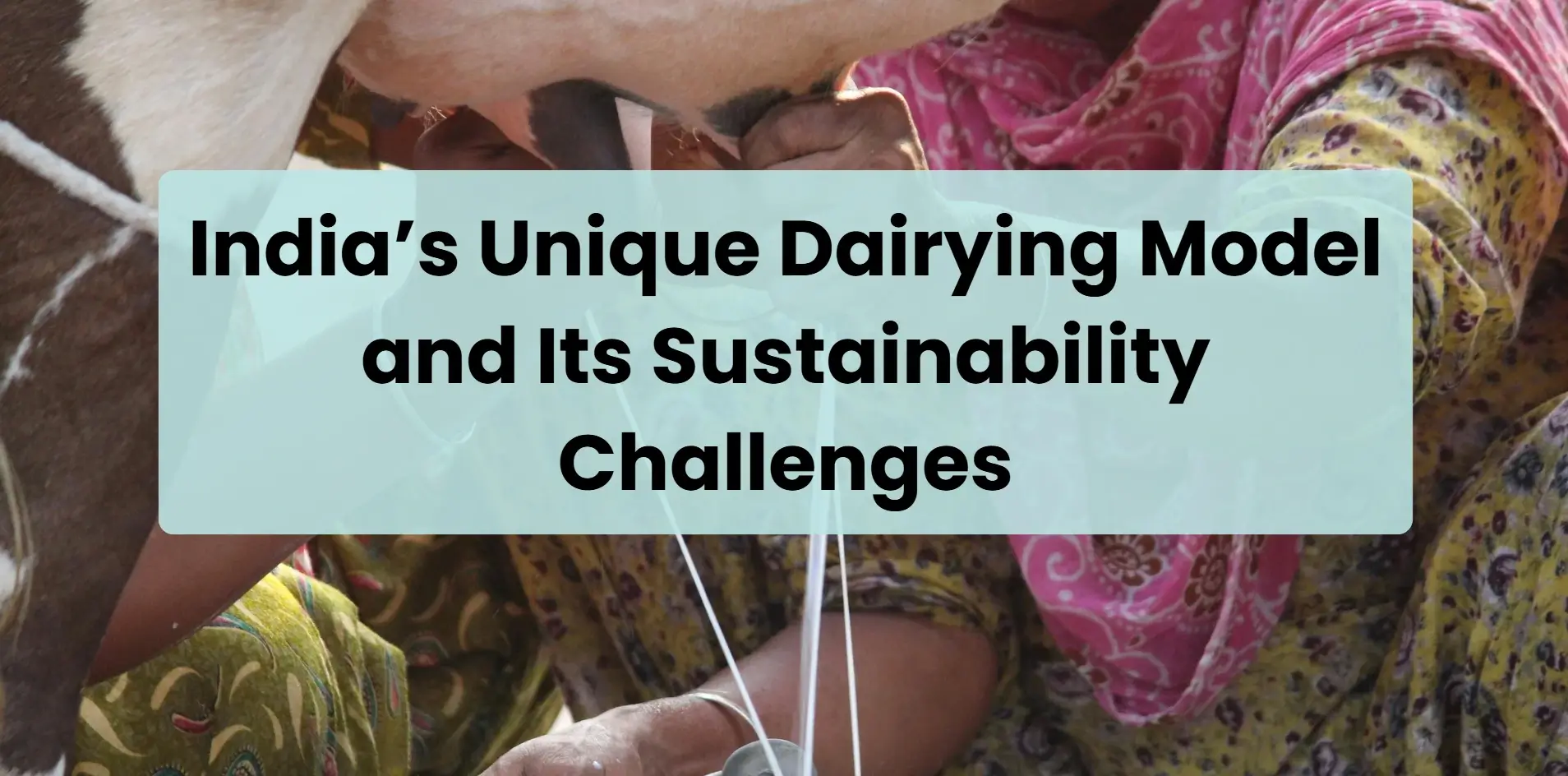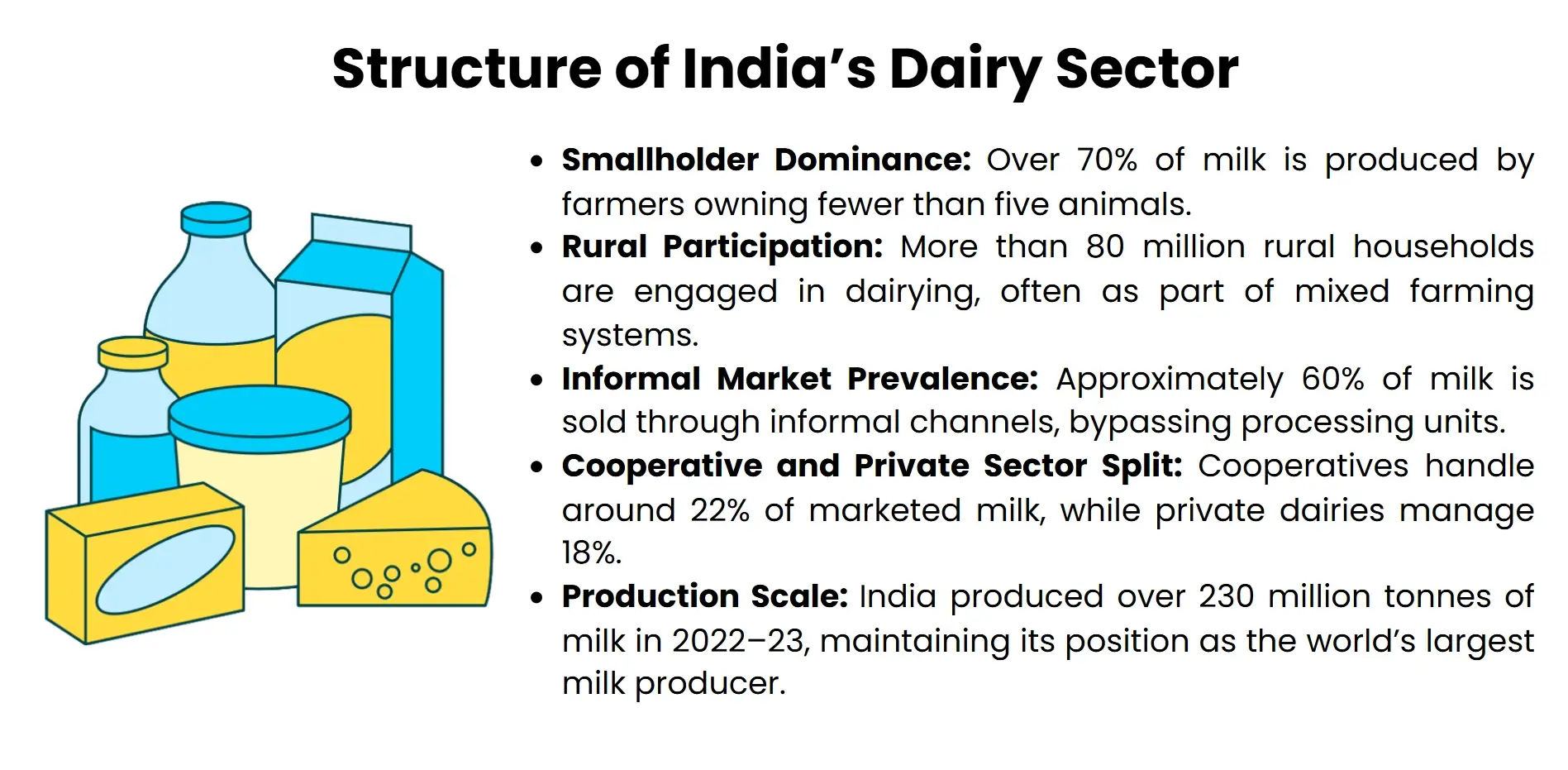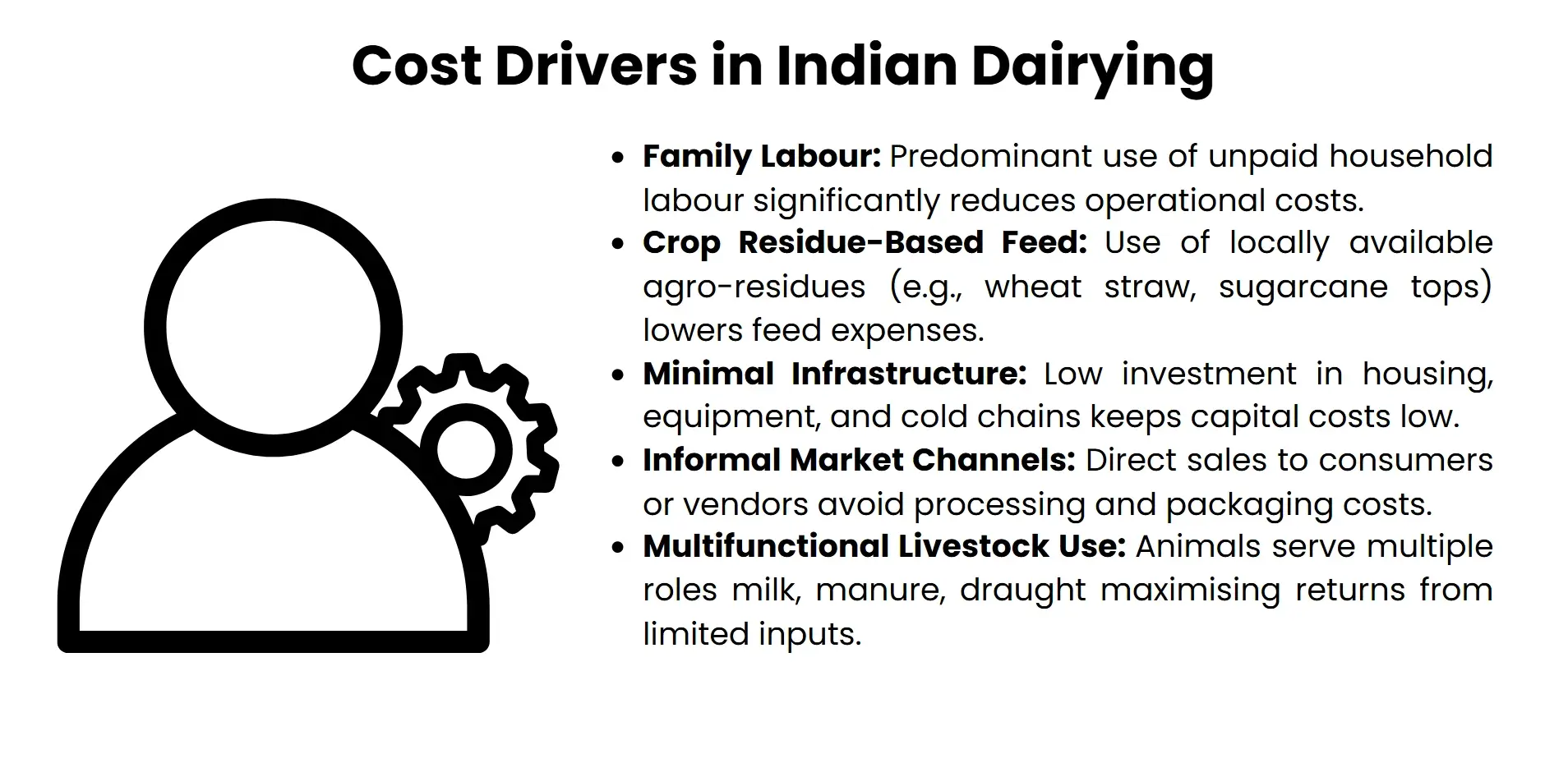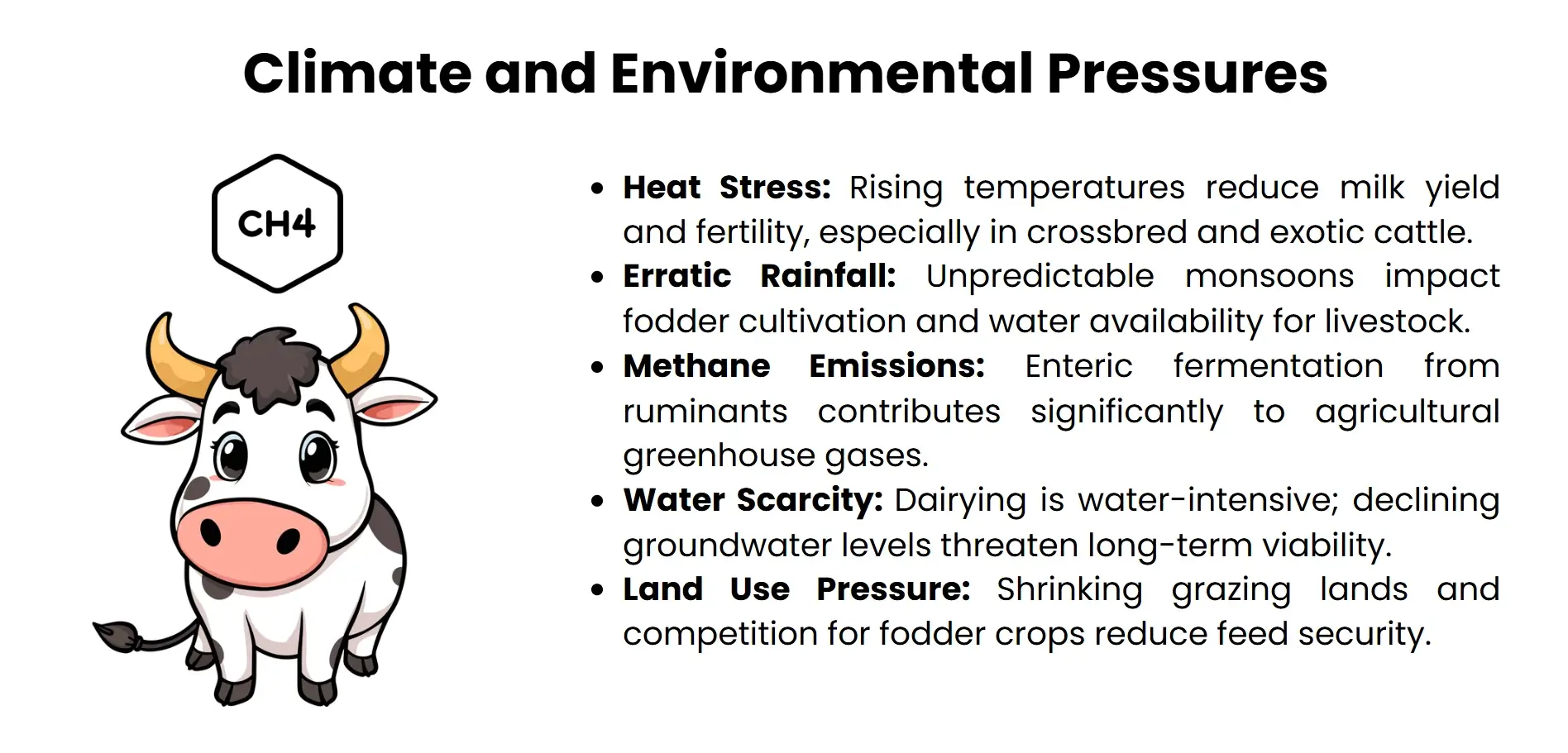Low-cost labour and the advantage of smallholders form the backbone of Indian dairying, but input cost pressures and sustainability are a threat to its global price competitiveness and overall viability.

The dairy sector in India can be perceived as a unique pattern of agricultural development, as it is based on the involvement of smallholders, co-operations or compartments of integration with mixed farming systems. India is acknowledged as the world's largest producer of milk, and the nation has increased milk production quickly while maintaining comparatively lower production costs. This cost advantage is brought about chiefly by the prevalence of family labour, low level of inputs, and decentralised production. The increasing wages in the countryside, shortage of feeds and fodders, climate-related pressure and changing international quality requirement are some other factors that challenge Indian price advantage that was long in place. Further, there is concern over the viability and resilience of the model that depends on low-cost labour as a structural pillar in a fast-changing rural economy.It is an important article to critically assess the basis of dairying model in India in terms of its economic and social foundations and emerging stresses that jeopardize its sustainability. It addresses how the relics of past practices intersect with a present-day requirement, and the necessity of interventionary measures concerning productivity levels, adoption of new technologies, and policy change.
India’s Unique Dairy Model
The dairying system in India is a model unique to the present-day global markets because it is characterised by input, inclusion of small holders, cooperatives, and interwoven with mixed farming. Its socio-economic embeddedness renders it resistant but also highly susceptible to the changes in structure.
The small-holder-based production system
Dairy farming in India is chiefly concentrated in the hands of small and marginal farmers who are often the owners of two to three milch animals. This decentralised unit also allows broad participation, including landless and rural households, which results in inclusive growth and employment in the rural sector. In contrast to industrialised dairy production, the Indian model occurs in the context of household economies in which livestock keeping supplements paddy and staple crop production.
Function of Cooperatives and Institutional Innovation
India has a successful dairy sector that finds its roots in the cooperative movement initiated during Operation Flood. This model was spearheaded by the National Dairy Development Board (NDDB) and gave the producers the ability to have collective bargaining, assured procurement, and offered producers veterinary and extension services. Other examples of organisations such as Amul show how producer-owned enterprises can be effective at creating efficiencies, which results in equity and grow to greater sizes, yet remain under the control of farmers.

Low Cost Input Strategy and Labour Dynamics
The cost competitiveness of India is due to the utilisation of crop residues as fodder, low rates of mechanisation and the use of unpaid family labour. These drivers minimise costs on inputs, as well as obscure productivity limits and weaknesses in labour. This labour-intensive model is struggling to be long-lasting as rural wages increase and the youngfolks working on farms leave the agricultural sector (FAO, 2020).
Embeddedness in Mixed Farming and Customs
Dairying in India is a culturally integrated process rather than an economic process. Cattle and buffaloes have several roles to play in functionally integrated farming systems-milk, manure and draught power. This multi-functionality increases recycling of resources and resilience but restricts specialisation as well as scale economies.
Factors that Influence Low-Cost Competitiveness
The dairy industry has been able to maintain price competitiveness at the global level through structural efficiencies and socio-economic factors that lower the cost of production.
Family Labour and Informal Workforce Dynamics
A major part of India'slow-cost dairy production is based on the help of family labour, which is free of charge. In the rural areas, women and children are usually in charge of all day-to-day care of the livestock, like feeding, milking and cleaning, but with no pay. This labour replacement drastically minimises operation costs as opposed to commercial systems of dairy production that require remunerated labourers. However, this model is sensitive to demographic changes, along with rural-urban migration and a lack of interest by younger generations of the population in agricultural labour.
Minimisation of the cost of feed
The dairy farmers in India are generally dependent on crop residues as sources of feed, like wheat straw, paddy husk and sugarcane tops. These agricultural by-products are locally/regionally available and economical, thereby decreasing the reliance on commercialfeed. Although this strategy can support affordability, it tends to reduce the nutritional adequacy (reducing milk yield and animal health). The weakness is that it is quite hard to maintain a balance between cost saving and productivity, facilitating feed interventions (FAO, 2020).

Low Costs of Capital and Infrastructures
However, in contrast to industrial dairy production systems that must invest in barns, milking machines, and cold chains, the dairying system in India is characterised by a lack of infrastructure. While milk is mostly sold as fresh milk in the unorganised sector, animals are housed in free or semi-pen houses. This is fairly lowcapital-intensive and this lowers the barrier to entry of others and makes it open to many. Nevertheless, it limits scalability, sanitary conditions, and the opportunity to access formal markets.
Decentralised production and short Supply chains
India has a highly decentralised dairy production involving millions of producers distributed all over the villages. This physical separation enables people to consume milk locally, which saves the cost of transportation and storage. The rural and those living in peri-urban areas benefit by the proximity of producers and their consumers guaranteeing affordable prices and fresh production. However, this model restrains the integration with national and export supply chains where the quality control and logistics of a company are vital (NDDB, 2022).
Cultural Embeddedness and Multi-functionality
In India, livestock are multi-functional in their capacities- milk giving, manure, draught power and as social capital. Such versatility increases economic robustness and responds less to intensive inputs. The cultural values of owning cattle and drinking milk in the households also support the idea of dairying as a family business and not as a commercial activity. Although this embeddedness enables low-cost operation, it can also be the stumbling block in transitioning to high-efficiency models.
Emerging Challenges
Though successfully coping with various challenges over the years of its existence, the dairy sector of India, today, has to struggle with a complicated range of structural, environmental, and economic issues that jeopardise its long-term sustainability and competitiveness in the global market.
Increasing labour costs and demographic fluctuations
The use of family labour free of charge is becoming unrealistic. Revised wage levels due to the availability of outside sources of alternative employment, i.e. construction, services and in government schemes like MGNREGA have increased rural wages. At the same time, lack of interest in agriculture and migration of youth into urban centres has resulted in a shortage of labour, particularly the physically demanding types of labour such as cattle rearing and maintenance of fodder. Such changes are undermining the cost advantage that was present due to cheap and plentiful labour.
Shortage of feed and Fodder
India also suffers a chronic shortage of green fodder and high-quality feed, made worse by changing land use patterns, uneven monsoons and sinking common grazing grounds. Extensive utilisation of crop residues is cost-effective, however does not support the nutritional requirements of high-producing animals. This causes low productivity and poor reproductive health. The sector has the potential to stagnate in the absence of strategic interventions in the areas of fodder cultivation, silage technology and feed efficiency (FAO, 2020).
Environmental Stress and Climate Change
The change in weather patterns and the trends in high temperature rates, declining and shifting rainfall distribution, extreme weather events, and theirincreased frequency all affect dairy productivity. Heat stress decreases milk production and fertility and water shortage damages both cattle and fodder. In addition, the industry has attracted the attention of climate-smart livestock management and mitigation efforts on methane emissions due to enteric fermentation.

Animal Health and Genetic Limitations
The dairy herd has poor genetic potential and poor veterinary coverage is present in India. Mastitis, foot-and-mouth disease, and disorders related to reproductive tract still exist and are most common among smallholders. Lack of access to good breeding service and inefficient use of artificial insemination are barriers to genetic advancement. To improve the productivity, the collection and enhancement of animal health infrastructure and genomic interventions are required (NDDB, 2022).
Liability to the Market Integration and Quality Standards
Informal milk markets are widespread in India rural regions, but they are not traceable, do not provide quality control, and keep no cold chains. With global dairy trade increasingly in the crosshairs of regulation, its sources in India are at a disadvantage due to their fragmented nature, which cannot deliver hygiene, safety, and consistency of level as required by regulators. Investment in processing, logistic and certification systems are needed to be done to unlock the export potential.
Directions to sustainable competitiveness
India has strong competitive advantages in its dairy sector as compared to other countries in terms of cost, but these advantages have to be redefined in the longer term to remain competitive. This demands strategic interventions in terms of productivity, infrastructure, policy and sustainability to fulfil new and upcoming domestic and global demands.
Increasing the productivity
Increasing the per-animal milk yield is at the centre of sustainable competitiveness. The average productivity of India has been low relative to the world standards because of their poor genetic make-up and low-quality feeding. The potential of genetics can be boosted through increased accessibility to artificial insemination, genomic selection and conservation of the indigenous breed. The use of balanced rationing, silage technology, and fortified feed supplements will simultaneously support deficiency in nutrients and enhance lactation performance.
Automation and cost-saving technologies
Mechanisation should be up-scaled in dairy operations to overcome the rising labour costs and shortage. Automatic milking machines, biogas-based heating systems, and mobile veterinary units would reduce manual labour dependence and enhance efficiency and hygiene. Online tools related to herd management, milk recording, and disease surveillance are also scalable and can be integrated to provide solutions to smallholders, in particular when combined with training and extension services (FAO, 2020).
Refrigeration Chains Cold Chain Enforcement
There is a lack of cold stores, transportation, and processing facilities in India, which hampers the dairy supply chain in the country. Developing chilling centres in the rural areas, milk testing laboratories, and processing facilities that are run by millers rather than handing them over to the cooperatives can lead to less loss of products after harvest and enhance product quality. Authoritative integration with professional retail and export channels presupposes traceability, certification of the quality and compliance with food safety standards.
Policy reforms and institutional support
The concept of being sustainably competitive is one which requires a coherent policy framework which incentivises productivity, sustainability and farmer welfare. Development and consolidation of dairy cooperatives, companies of producers, and farmer collectives will help increase the bargaining power and market access. Moreover, environmental objectives (mitigation of methane, water conservation, etc.) should be introduced into dairy policy-making so that the viability of the production in the long term would still be possible (NITI Aayog, 2020).
Climate Adaptation and Sustainability Measures
Climate-smart dairying should be part and parcel of India's strategy. Popularisation of heat-adapted breeds, water conservative fodder crops and weather-resistant housing structures can rescue some climate threats. Feed supplements that reduce the production of methane, manure treatment systems and carbon credits are possible avenues towards emission mitigation. The development of dairy extension and certification programs through integrating sustainability measurements into it will serve to align the competitiveness withenvironmental stewardship (FAO, 2020).
Conclusion
The dairy industry in India isa distinctive one. The distinctive nature of its model (based on smallholder involvement, coalitions of agricultural cooperatives, and low-cost output) has produced astounding growth and rural inclusivity. Nevertheless, the foreign countries rely upon cheap labour, informal markets and low-input systems, which are becoming increasingly unviable due to increased wages, climate pressures and international standards. A developing economy like India has to move on to productivity-led resilience as opposed to cost-based development. This necessitates both strategic investments in genetic enhancement, feed conversion, mechanisation and cold chain infrastructure, as well as policy change that will involve clear incentives to sustainability and empowerment of producers. The capacity to innovate institutions will be essential to achieve the balance between affordability, quality and environmental protection. Indian dairying needs to rethink its historical cost advantages rather than demographic and ecological realities by including and involving more people in new, technological, environmentally sustainable channels. Only under this circumstance, India can maintain its leadership in world milk production, as well as livelihood and nutritional safety of people over generations.